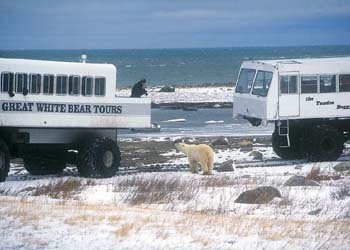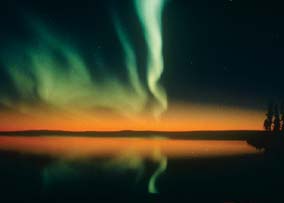Bears,
Birds and Belugas on the Edge of the Arctic
The plane droned due north from Winnipeg
for three long hours, crossing endless forests and thousands of lakes
that gave no hint of the nature experience that was to come. My destination
was Churchill,
nestled on the edge of the Arctic on the western rim of Hudson
Bay. This remarkable town is not only a thriving seaport but,
as I was to discover, it is also a nature-watching wonderland, providing
an experience that can only be matched by a big-game safari in deepest
Africa. |
|||||
|
|
|||||
The plane
descended into a desolate terrain of tundra
composed of rocky outcrops and marshy land lying just past the edge
of the boreal
forest with the cold ice of permafrost
only a few feet below. Soon we were in What has brought fame to Churchill is its proximity
to the largest concentration of polar bears in the world. In the late
fall the bears, the |
|
||||
A safe and unusual way of observing polar bears has been devised: the towering tundra buggy with wheels almost the height of a person. Although it was mid summer and bear sightings were not expected, we clambered aboard and rumbled into the tundra, dotted with scrubby black spruce, rocky outcrops, and many small shallow lakes. The Churchill area is one of the best birding places in North America and we saw numerous flocks of snow geese and Canada geese, a family of ptarmigans almost invisible in their camouflage colouring, northern shrikes, Hudsonian godwits, old squaw ducks, mergansers, gulls, three large sandhill cranes lumbering into flight with their enormous wings, and arctic terns that migrate each year from the southern tip of South America. Then a caribou adorned with enormous antlers loomed out of the mist, posing majestically on a rise. The guide explained that two caribou herds numbering almost 800,000 animals live to the northwest migrating each fall and spring in a thundering mass. The following day, a jetboat carried us out into the river estuary dotted with Beluga whales. The Belugas are not much bigger than dolphins, white in colour, and remarkable talkers-we heard them chattering via a hydrophone lowered into the water. Every summer about 3000 whales live here until freeze up and we saw hundreds of them. Some inspected the hydrophone, looked us in the eye, and spouted water at us from about two metres away. You could not help but feel a deep empathy for these large and intelligent creatures. They are so plentiful and gentle that you can swim amongst them in the warm waters of the estuary-a once in a life-time experience. On our return the sun was low in the west with golden light glistening on the water and illuminating the grain elevator that towered over the town like a fortress. Although darkness comes late in the summer, it is worth staying up to witness the northern lights dancing overhead in shimmering curtains of green. Churchill is one of the prime locations in the world to view this magnificent show, especially in winter. The Japanese are starting to flock here for they believe that a child conceived under the aurora borealis (northern lights) will be exceptionally intelligent. Churchill is also blessed with a rich history dating to the 1600s. Across the river lies Prince of Wales Fort, where I was again reminded that this is the domain of the polar bear. A Parks Canada guide with a shotgun, a starter's pistol, and mounted on an all-terrain vehicle guarded our group as we strolled from the dock to the fort. The British built this impressive fort with five-metre thick walls in the mid 1700s to protect the fur trade, but then surrendered it to the French in 1782 without a shot being fired. Now the fort lies in lonely isolation in its setting of moor-like tundra. All too soon it was over, and the plane droned back toward civilization over the lake-speckled tundra leaving behind a very special place, for where else can you swim with whales, see mighty polar bears up close, hear the thunder of thousands of caribou migrating, and conceive the world's smartest child below a night sky filled with shimmering sheets of brilliant colour. Hans recommends: To see polar bears, book well in advance. Travel by Calm
Air or Via Rail
(36 hours) from Winnipeg. |
|||||


